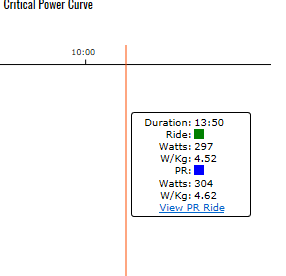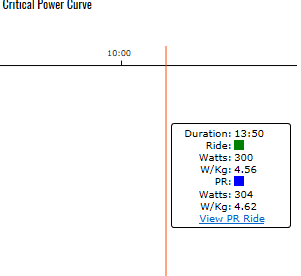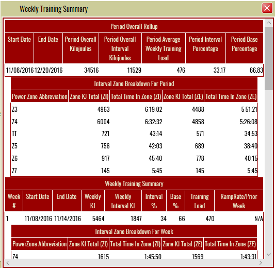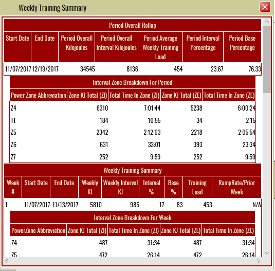Fall Training
Happy Solstice everyone! We're finally starting to climb out of the tunnel towards warmer days and the 2018 cycling season. It's a good time as a cyclist for self assessment: How good a job did you do laying the groundwork for the upcoming season?
To figure it out for myself, I decided to reproduce a test I did last year the Tuesday before Christmas: An all out TT on Zwift's Watopia flat course. This is a 6.3 mile effort which is more then enough for this time of year! This year was 3 watts better then last year, (300 vs 297). Although 3 watts doesn't sound like a lot, 300 was as high as I got this past season for a 20 minute effort. The closer one gets to their genetic potential, the harder it is to improve, so I'm happy with a 3 watt improvement. Here's a couple of screenshots from the KOM Informatics app showing both tests:

Dec 20 2016 Test

Dec 19, 2017 Test
So, how did that improvement happen?
It's all too easy to relax too much in the fall and make the climb back to in-season fitness that much more difficult. On the other hand adhering to in-season routines can lead to burnout.
I like to maintain a middle ground in the fall, trying to hold onto as much fitness as possible. For me, it's hard to maintain training load as the weather shifts colder, leading to more indoor, shorter rides. But maintaining intensity on trainer rides is definitely doable.
On top of just maintenance, I also wanted to improve my legs on TT style efforts. I made this judgement based on feel: The "legs are burning" sensation was harder to tolerate then the "help, I'm starting to drown" sensation (which seems to imply a cardio problem) both of which can occur during time trials.
So, my general plan for the Fall was to try to enjoy the outdoor season as long a possible, and then hit Threshold intervals (Zone 4) at least moderately hard. The plan also called for at least doing some VO2Max (Zone 5) intervals, but I felt like I definitely backed off on these compared to in-season levels. See the "Expected physiological adaptations from training in Zones 1-7" chart from Dr. Andy Coggan for the details on how these intervals help legs. https://fascatcoaching.com/tips/training-zones/
In addition to the Zone 4 and 5 work, I got inspired by Chris Yura's posts on his Tabata sessions to start trying a few of these. A Tabata interval is a 20 or 30 second all-out zone 7 effort. If you're doing them right (and I can't at this point) they are at 170% of your VO2Max wattage, with only 30 seconds of rest in-between. I added Tabatas to my Sunday workout which is just Zone 2 otherwise. If you're interested in how anaerobic Zone 7 efforts can help TT performance which is an aerobic effort see this article:http://sportsci.org/jour/0101/cf.htm.
To assess how well I stuck with my plan, and to figure out why I performed better in 2017 compared to 2016, I used a report built into KOM Informatics, a cycling analytics program I'm working on. The system has what I call a Race Readiness graph which is analogous to tools like Strava's Fitness & Freshness graph, or Golden Cheetah's Performance Manager.
One thing you can do from the Race Readiness Graph is to select days on which you've had interesting results, and generate a Training Summary report for the 6 weeks prior to those days. The report provides summary information, such as Period Overall Kilojoules (how much energy you burned on your rides), and Period Average Weekly Training Load, as well as total times for interval training in each of the zones you've trained in. Here are screenshots of the reports for the 6 week training periods prior to each test.

2016 Training Summary For 6 Weeks Prior To Test

2017 Training Summary For 6 Weeks Prior To Test
- Overall kilojoules were virtually identical 34516 KJ for 2016 vs 34545 KJ for 2017. To put that in perspective I burned 309 KJ on an easy half hour ride. So it's about 5% of an easy half hour ride. I'm going to cross this off the list of potential explanations for the improved performance :).
- The weekly training load for the 2016 was higher then in 2017, 476 to 454. That's almost a 5% difference. Yet I got a worse result in 2016. If we just looked at training load, we might predict a better result for 2016. I'm going to cross this one off the list of potential explanations as well.
- Interval kilojoules were significantly higher in 2016 then 2017 11529 vs 8136. That's almost a 30% difference! Looking at the Interval Zone Breakdown tells the story: 4488 of those 11529 2016 interval KJs came in the form of Zone 3 intervals. The way I've set up my interval detection in the system, I have to ride 2 1/2 hours at once in Zone 3 for it to count. This is not easy to do, and most definitely provides a training effect. But my working theory is that Zone 3 interval work won't affect TT performance as much as work in the higher zones. If it did, my 2016 result should have been the better one.
The Interval Zone Breakdown highlights some additional differences between 2016 and 2017.
- Zone 4 work was a little higher in 2017 5238 KJ vs 4858KJ about a 7% difference. I was a little surprised that the difference wasn't greater.
- I did way better at maintaining Zone 5 work in 2017: 2218 KJ vs 778 KJ almost a 65% increase. 2218 KJ is only about 10% down from a number of comparable 6 week periods from last season. I was surprised I did this well in 2017, and also surprised at the lack of Zone 5 work in the 2016 period.
- Another notable difference between 2016 and 2017 is Zone 7 work. 2017 outpaced 2016 252 vs 145 KJ, a 43% increase. The 2016 work in this zone represented random 15 second bursts, whereas the 2017 work is almost all focused, semi-structured Tabata efforts.
The take-aways?
- It was good to have the Training Summary reports which provided an objective measurement of the composition of my training. I didn't pay any attention to Fall 2017's reports, and didn't have last Fall's rides loaded until it came time to do this assessment. I got a couple of surprises, I expected more of an increase in Zone 4 work, and less of an increase in Zone 5 looking at 2016 vs 2017.
- Tweaking the composition of training can yield enhanced results for the same amount of overall effort. Training for bike racing is hard if you're doing it right it's going to hurt. Might as well try to optimize your results for the price you have to pay. In order to do this with any accuracy though you need to know what it is you're tweaking.
I think it's most useful to attribute my performance gains to the increased work in Zones 4, 5 and 7. It's impossible to isolate any individual factor. Unfortunately I can't clone myself and conduct randomized trials with different combinations of workloads!
Looking forward to January 2018 I'll be using Fall 2017's summary as a starting point to try to achieve further gains. I'll try to ramp up the Zone 4 and Zone 5 work a little bit while maintaining the existing ratio. Since I just started doing Tabata work 3 weeks ago, I think there is significant room for improvement. During January I'll add more Tabata reps and bring them closer together. I'll test again at the end of January to see what's up.